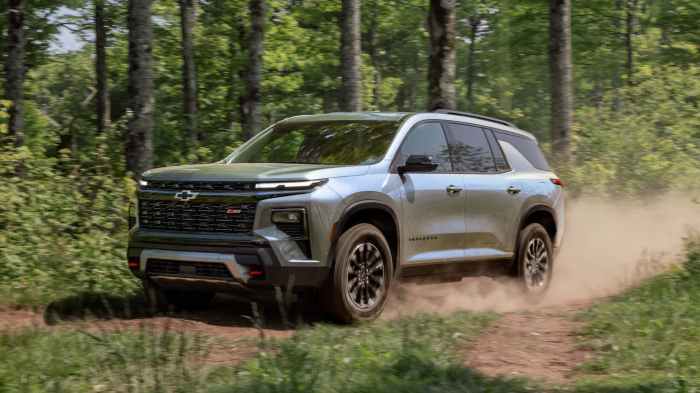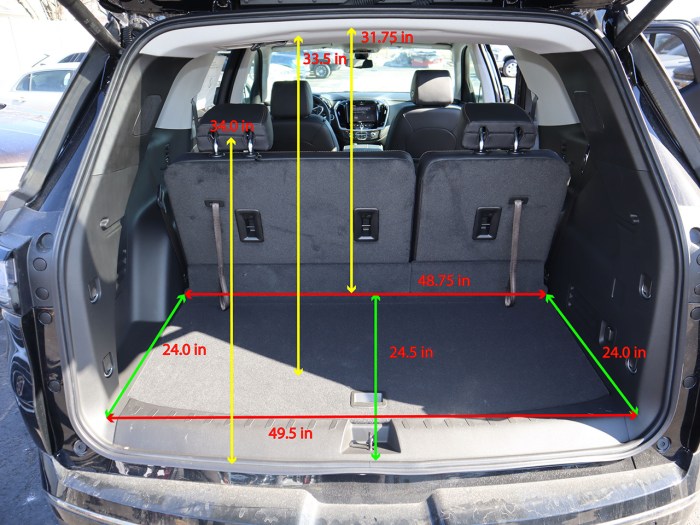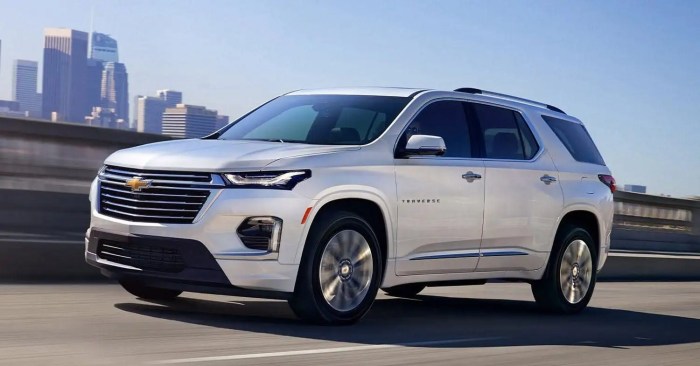Toyota 4Runner vs Chevrolet Traverse: A Detailed Comparison – Choosing the right SUV can be a daunting task, especially when faced with compelling options like the Toyota 4Runner and the Chevrolet Traverse. These two vehicles cater to different needs and preferences, making a direct comparison crucial for informed decision-making. This detailed analysis will explore the key differences and similarities between the Toyota 4Runner and the Chevrolet Traverse, helping you determine which SUV best aligns with your lifestyle and priorities.
Body Style and Design: Ruggedness vs. Refinement
The 4Runner and Traverse represent distinct design philosophies. The 4Runner embraces a rugged, body-on-frame construction, exuding a sense of off-road capability. Its boxy design, high ground clearance, and available features like skid plates and tow hooks reinforce this image. The Traverse, on the other hand, adopts a more refined, car-like unibody construction, prioritizing on-road comfort and passenger space. Its sleek lines and modern styling appeal to those seeking a more sophisticated SUV experience.
This fundamental difference in design philosophy impacts nearly every aspect of their performance and capabilities.
Exterior Styling: A Tale of Two Designs
The Toyota 4Runner’s design has remained relatively unchanged for years, maintaining its iconic, rugged aesthetic. This consistency appeals to those who appreciate its timeless look and proven durability. The Chevrolet Traverse boasts a more contemporary design, featuring smoother lines and a more modern front fascia. The Traverse’s styling is more likely to appeal to buyers who prioritize a sleek and updated appearance.
Consider your personal preference for a classic, rugged look versus a more modern, stylish design when making your decision.
Interior Design and Features: Comfort and Technology
Inside, the 4Runner and Traverse offer contrasting environments. The 4Runner’s interior, while functional, can feel somewhat dated compared to the Traverse. However, its straightforward layout and durable materials are appreciated by many. The Traverse offers a more modern and upscale interior, with higher-quality materials and more advanced technology features. This includes larger infotainment screens, more advanced driver-assistance systems, and more comfortable seating for passengers.
The Traverse typically offers more passenger and cargo space, making it better suited for larger families or those who frequently haul cargo.
Performance and Capability: Off-Road Prowess vs. On-Road Comfort
The 4Runner and Traverse diverge significantly in their performance capabilities. The 4Runner, with its body-on-frame construction and available four-wheel-drive system, excels in off-road situations. Its robust build and high ground clearance allow it to tackle challenging terrains with confidence. The Traverse, built on a unibody platform, prioritizes on-road comfort and handling. While available with all-wheel drive, it’s not designed for serious off-road adventures.

Source: motor1.com
Its focus is on a smooth, comfortable ride and responsive handling on paved roads. Consider your driving needs – do you require serious off-road capability, or will on-road performance suffice?
Engine Options and Fuel Efficiency: Power and Economy
Both vehicles offer a range of engine options, each impacting fuel efficiency and performance. The 4Runner’s engine choices typically offer more power for towing and off-roading, but often come at the cost of lower fuel economy. The Traverse, on the other hand, may offer more fuel-efficient engine options, better suited for daily commuting. Review the specific engine options and EPA fuel economy estimates for each model year to make an informed choice based on your driving habits and fuel budget.
Check the official websites of Toyota and Chevrolet for the most up-to-date information.
Safety Features: Protecting Passengers, Toyota 4Runner vs Chevrolet Traverse: A Detailed Comparison
Both the 4Runner and Traverse offer a range of advanced safety features, including airbags, anti-lock brakes, and electronic stability control. However, the specific features available may vary depending on the trim level. Modern safety technologies such as adaptive cruise control, lane departure warning, and automatic emergency braking are increasingly common in both vehicles, but availability should be confirmed for the specific model year and trim level you are considering.
Research the safety ratings from organizations like the IIHS and NHTSA to compare the safety performance of each vehicle.
Price and Value: Balancing Features and Cost
The price point of the 4Runner and Traverse varies depending on the trim level and optional features. Generally, the Traverse tends to have a lower starting price than the 4Runner, making it a more budget-friendly option for some buyers. However, the 4Runner’s higher price often reflects its greater off-road capability and more rugged build. Consider your budget and prioritize the features that are most important to you when comparing the overall value proposition of each vehicle.
Frequently Asked Questions (FAQ)
- Q: Which SUV is better for off-roading? A: The Toyota 4Runner is significantly better suited for off-roading due to its body-on-frame construction, higher ground clearance, and available four-wheel-drive system with more robust features.
- Q: Which SUV offers more passenger space? A: The Chevrolet Traverse generally provides more passenger space and cargo capacity than the Toyota 4Runner.
- Q: Which SUV is more fuel-efficient? A: The Chevrolet Traverse typically offers better fuel economy than the Toyota 4Runner, though specific fuel economy varies greatly depending on the engine and trim level.
- Q: Which SUV has a more modern interior? A: The Chevrolet Traverse generally boasts a more modern and upscale interior with better technology features compared to the Toyota 4Runner.
- Q: Which SUV is better for towing? A: The Toyota 4Runner typically offers a higher towing capacity than the Chevrolet Traverse, making it a better choice for those who frequently tow heavy loads. Always check the manufacturer’s specifications for the exact towing capacity of the specific model and trim level.
Conclusion: Choosing the Right SUV for You: Toyota 4Runner Vs Chevrolet Traverse: A Detailed Comparison
The choice between the Toyota 4Runner and the Chevrolet Traverse ultimately depends on your individual needs and priorities. The 4Runner excels in off-road capability and rugged durability, while the Traverse prioritizes on-road comfort, passenger space, and modern amenities. Carefully consider your driving style, passenger needs, budget, and desired features before making your decision. Test driving both vehicles is highly recommended to experience their distinct characteristics firsthand.

Source: autoknowledge.com
Call to Action
Ready to find the perfect SUV for your lifestyle? Visit your local Toyota and Chevrolet dealerships to explore the available trims and options and schedule a test drive today!

Source: dealerinspire.com
Q&A
What is the towing capacity of each vehicle?
The towing capacity varies depending on the specific trim level and configuration, but generally, the Chevrolet Traverse offers a higher towing capacity than the Toyota 4Runner.
Which vehicle has better fuel economy?
The Chevrolet Traverse typically boasts better fuel economy figures than the Toyota 4Runner, especially in city driving.
Which SUV is better for off-roading?
The Toyota 4Runner is significantly better equipped for off-roading due to its four-wheel-drive system and higher ground clearance.
What is the starting price range for each vehicle?
Prices vary by year, trim level, and location, but generally, the Chevrolet Traverse has a lower starting price than the Toyota 4Runner.
